Fig. 1
Standard Scores from 90 to 109 are considered to be in the Average range
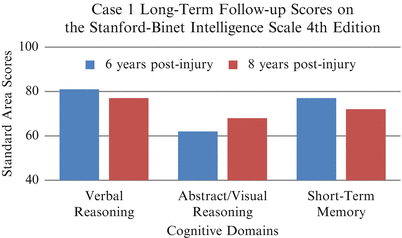
Fig. 2
Standard area scores of 89–111 are in the average range
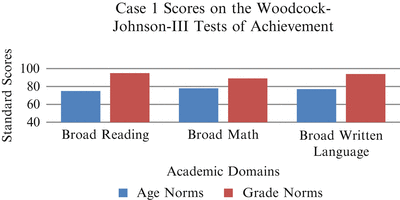
Fig. 3
Standard scores of 90–109 are in the average range
TBI in School Aged Children and Adolescents
Meta-analysis of cognitive outcomes after pediatric TBI [43] found that the most significant chronic effects of moderate and severe TBI were evident in intellectual functioning, processing speed, attention, working memory, fluency, inhibition, problem solving, and delayed recall of newly learned verbal and visual information from memory. Improvement over time was greatest in Performance IQ, processing speed, and working memory [43]. In contrast, memory and learning did not show significant improvement over time. Impairments have been noted on tests of verbal and visual learning [44–48] for children with severe TBI. The persistence of learning and memory difficulties is unfortunate, since one of the major developmental tasks of childhood and adolescence involves learning the academic curriculum.
Unlike infants and preschoolers, older children and adolescent survivors of severe TBI have acquired academic and other abilities prior to their injury, which may confer greater cognitive reserve. However, previously learned skills and abilities can appear relatively intact during the early stages of school re-entry following TBI, giving the false impression to educators and parents that the ability to learn, retain, and implement new skills is intact. Academic outcome studies have found that school-aged children and adolescents with severe brain injuries scored lower on measures of reading, spelling, and mathematics than children with moderate TBI [49] and struggled with mastering new information and skills [50]. Children with severe TBI from families with fewer socioeconomic assets are at increased risk for poorer academic performance [51]. Catroppa and Anderson [52] found that premorbid academic ability (based on teacher’s ratings of academic skills) and verbal memory skills were significantly predictive of academic attainment. Children with pre-injury intellectual or learning disabilities are extremely vulnerable to post-traumatic exacerbation of their academic difficulties [45].
Are there alterations in metacognitive processes that underlie the post-traumatic disruption of diverse cognitive and academic skills? Metacognition is “knowing about knowing” and includes being able to use certain strategies for problem-solving and learning. Hanten and colleagues [53–56] have found that post-traumatic difficulties in metacognitive abilities, such as categorization, using learning strategies, and directing learning resources to the most important information, contributed to poor academic performance. Similarly, Barnes [57] found that children with TBI had specific difficulties making inferences to support their comprehension. Even when they understood and remembered factual information from a story, they were inefficient at holding different sources of relevant information in working memory long enough to make inferences. They also had problems knowing when an inference was required to understand what they heard. These examples highlight ways in which specific difficulties in working memory, selective attention, and metacognitive strategies may disrupt everyday cognitive and academic performance. Metacognitive difficulties may represent fruitful targets for intervention.
Childhood TBI has been associated with significant and persistent changes in social development and adaptive functioning [58–62]. Children with severe TBI have been found to have long-term issues in developing friendships and social contacts, and are more likely to exhibit social withdrawal [63]. Certain sequelae of severe TBI such as cognitive and behavioral functioning were more marked in the context of higher compared with lower levels of family burden or dysfunction [27, 51]. Studies examining neuropsychiatric outcomes at least 1 year post-injury have found elevated rates of emotional disorders, mixed emotional and cognitive disorders, attention-deficit/hyperactivity disorder (ADHD), major depressive disorder, and conduct disorders [64, 65]. Anxiety and mood disorders are commonly identified [65–71]. Prefrontal damage, as well as injury to deep gray matter structures such as the amygdala, places children with TBI at high risk for neuropsychiatric and behavioral difficulties [68, 71–75].
Family functioning has been found to be a significant predictor of outcome from brain injury in children. In school-aged children and adolescents with TBI, Yeates and colleagues [76] found that after accounting for injury severity, pre-injury family environment significantly predicted cognitive and behavioral outcome 1 year post-injury for children and adolescents with TBI. Taylor and colleagues [12] found that higher parent stress at 6 months post-injury predicted more child behavioral difficulties at 12 months post-injury and more child behavior problems at 6 months predicted worse family outcomes at 12 months post-injury. In essence, they found a bidirectional influence of child and family on outcomes following brain injury.
Assessment of School-Aged Children with TBI
Numerous measures are available to assess intellectual, neuropsychological, behavior, academic, and social functioning in school-aged children with TBI. The Pediatric CDE Working Group identified measures which were considered to be valid, robust, and widely used in clinical research with children with TBI [10]. Although a mainstay of neuropsychological evaluations, comprehensive assessment of intellectual functioning may not be as useful for rehabilitation planning and treatment as briefer and more focused assessment that can be repeated to track recovery. Assessment batteries should include tests that focus on areas that are commonly disrupted by TBI as well as tests of abilities that are targets of intervention.
Assessment of children with TBI includes many of the same domains as assessment of adults with TBI: executive functioning, memory, attention, processing speed, and motor skills. Perhaps the greatest distinction between the assessment of children with TBI and adults with TBI is the need for educational planning and treatment for the former. Although academic assessment is often not covered by third party payers, assessing the child’s academic functioning is highly relevant for the child’s habilitation. For children, school is the primary place where they are taught and are expected to perform. It is in essence their work environment. Many insurance carriers do not cover the cost of academic assessment because of an inappropriate expectation that the public schools are responsible for providing this service for the children. However, most school professionals do not have the background or familiarity with TBI to interpret the academic test findings in the context of the child’s brain injury. Assessment of academic functioning should include basic word decoding, reading comprehension, math calculation and reasoning, and expressive writing skills. Given the cognitive and motor slowing that commonly occurs following severe TBI, performance on measures assessing academic fluency, or the speed and efficiency at which the child is able to work, are an essential component of any battery. Curriculum-based assessments are also valuable for assessing retention of academic material.
Return to School
A critical factor contributing to the identification of students with TBI for special education is the link between hospital and school [77]. The majority of children with severe TBI will require special education support [78]. For children with moderate to severe TBI, transition from hospital to school is done gradually. Children in inpatient rehabilitation units often receive onsite teaching services from the local school district. Following discharge, interim homebound teaching which is provided by the child’s public school is recommended for many children with severe TBI. Children with mild to moderate TBI vary in their stamina, strength, and attention and some may require a gradual transition to school. Re-entry to the school environment for most children with TBI, regardless of injury, is recommended to begin with a half-day placement with time in school increasing as the child’s stamina improves [79]. Children with mild TBI can suffer from physical fatigue and confusion that impact their return to school. Returning a child to full-day school too quickly can be detrimental to the child’s well-being. Readjustment to the school environment depends on the transition plan designed by the student’s rehabilitation or hospital team [80].
Often times, the mere presence of a brain injury is not sufficient to obtain special education services. An educational need must be demonstrated. In a study conducted by Glang and colleagues [77], only 25 % of children with TBI were identified for formal special education services. Over 41 % received informal supports (e.g., schedule change, extra time on tests). Injury severity and hospital–school transition services were predictive of provision of special education services. Clearly, children with TBI are under identified by school personnel and better linkages between medical and educational systems are needed.
Despite the high incidence of TBI in children, many school personnel are unfamiliar with TBI and this unfamiliarity with the sequelae of brain injury can lead to less than satisfactory educational services [81]. A comprehensive neuropsychological evaluation provides information that can be used to help justify educational need and help guide the family and school personnel in developing appropriate accommodations and interventions. Including links to the websites with resources for educators in the neuropsychological report provides an opportunity for educators to learn more about the challenges facing their students with TBI.
There are two paths by which a student with TBI can receive special education services in the public school systems. TBI is a qualifying condition for receipt of special education services under the IDEA, which was most recently reauthorized in 2004. Under this legislation, a child must be assessed in all areas related to his or her suspected disability. The evaluation must identify the child’s needs for both special education and related services. Related services include speech-language pathology and audiology services, and physical and occupational therapy. In addition, psychological and social work services may be included. Based on the comprehensive evaluation, an individualized educational plan, often referred to as an IEP, is developed. The IEP must address the child’s current level of functioning (sometimes referred to as performance), list annual goals, describe the measurement of progress to meet goals, and list specific special education services and accommodations.
The IEP is developed and written by a team that includes the parents or guardians, teachers, and other professionals at the school, most likely the school psychologist, speech/language therapist, and physical therapist. This team is referred to as the Assessment, Review, and Dismissal (ARD) committee. The ARD committee will convene a meeting to develop the IEP within 30 days of deciding that the child is eligible for special education services. The IEP must be reviewed every year to insure that it is meeting the educational needs of the student although the ARD committee can convene as often as needed. Particularly during the first year after TBI, the committee should meet periodically since improvement is likely to be uneven, with significant gains in some areas and less in others. IEP goals will need to be adjusted depending on the rate of recovery or improvement [82]. In addition, we often suggest to the IEP committee that safeguards be put in place regarding the child’s safety. Children with severe TBI are vulnerable to manipulation and abuse by their peers. The school must take precautions to ensure a safe and supervised environment, taking into account the child’s right to an education in the least restrictive environment.
Some students with TBI will need a Behavior Intervention Plan (BIP) to address the prevention of maladaptive behaviors associated with the brain injury. The BIP should focus on positive behavior supports and may include parent or in home training. BIPs are also important for students with TBI who are unable to follow the rules of conduct at school. Students with TBI may not respond to traditional contingency management protocols because of impaired self-regulation, poor initiation, and difficulties with contingency learning [83]. Positive behavior intervention and supports (PBIS) is an antecedent-based intervention that has been demonstrated to have some efficacy in students with TBI in a series of single subject studies [83–85]. PBIS differs from traditional behavioral intervention methods by focusing more on lifestyle changes through internal control of behavior. There is a focus on control of antecedents including events that occurred earlier as well as internal events such as loneliness. The environment is adjusted to meet the needs of the student so that that there is a high degree of success. The intervention is conducted in naturalistic settings such as home and school and involves the student’s primary caregivers.
Another avenue by which students receive educational accommodations is by Section 504. Often simply referred to as “504,” Section 504 is a federal civil rights law that prohibits discrimination against individuals with disabilities. Section 504 provides children with disabilities equal access to education and as such, they are allowed educational accommodations and modifications. These accommodations and modifications are for the general curriculum and do not include additional therapeutic interventions outside the classroom. The 504 plan does not provide an educational program that is tailored to the child’s needs. For children with mild to moderate TBI, who are able to make adequate progress in the general curriculum with accommodations such as extended time for classroom assignments and tests, a 504 plan may be an acceptable option by which to receive accommodations in the schools. However, for children with moderate to severe TBI who have extensive cognitive and/or physical impairments, an IEP should be implemented at the school.
In our experience, children with TBI are often erroneously classified for special education services with the most common classification being ADHD. Children with TBI may have premorbid developmental disabilities such as ADHD that necessitated special education services [45, 86]. However, comorbid TBI has a significant impact on the child’s abilities and functioning and these changes need to be addressed by the school in order for the child to receive an appropriate education. To illustrate, we were contacted by the family of a boy who had sustained a severe TBI several years earlier. The family lived in a small community in a rural part of the state. The student had premorbid ADHD and had an IEP in place at school under the qualifying condition of “Other Health Impairment.” The child’s classification to receive services was ADHD, not TBI. Despite having an IEP in place at school, he was failing most classes because he was unable to pass tests. In a phone conference with the school, it quickly became apparent that although some members of the committee were aware that the child had been in an “accident,” no school personnel were familiar with TBI and the sequelae from severe brain injury. In our conversation with the school, we ascertained that the student was consistently failing short answer and essay tests formats. An earlier evaluation of the child had revealed impaired performance on free recall verbal memory and verbal learning measures but significantly higher performance on recognition or multiple choice format tests. When the child’s impairments were discussed with the ARD committee, we suggested the use of recognition format for all examinations. The accommodation was accepted and the student’s test performance significantly improved.
Case 2: Adolescent with Severe TBI
Ann was a 14-year-old adolescent who sustained a severe TBI in a motor vehicle collision. Prior to the TBI, Ann was an honor student who attended a private school. She excelled in academics and was a competitive gymnast. She had an extensive social network and was emotionally well-adjusted. Ann had an admission Glasgow Coma Scale score of 6T. A CT of the brain conducted on the day of admission revealed diffuse axonal injury, bilateral frontal lobe contusions, a right subdural hematoma, and an intraventricular hemorrhage. Upon arrival at an inpatient rehabilitation unit, she was not verbal and only minimally responded to commands. After a 2-month stay in rehabilitation, she was discharged with a dense right-sided hemiplegia and dysarthria. Ann’s initial neuropsychological evaluation was performed 1 day after discharge from inpatient rehabilitation, roughly 3 months post-injury. This evaluation allowed for documentation of Ann’s impairments as well as data that could be used to track her recovery over the next several years. The initial evaluation was limited to 1.5 h of testing because of Ann’s fatigue and attentional issues. Ann was not oriented to the day, date, or time. She was unable to name the facility she had been in for the past 2 months. She struggled with completing activities of daily living. She needed help sequencing self-care activities such as showering and brushing her teeth. The brief evaluation assessed her memory skills as well as basic academic skills. As indicated in Fig. 4, Ann had significant impairments on verbal and visual memory tasks on the Wide Range Assessment of Memory and Learning (WRAML). Her performance on the Woodcock-Johnson Tests of Achievement-Revised [87] was well below age and grade expectancies. She had a left visual field cut which greatly impaired her reading. She required cueing to start at the far left side of a sentence, following with her finger till she reached the end. She was unable to consistently recognize numerical operators and struggled with basic multiplication. When she was shown how to solve a math problem, she then was able to solve the next similar problem. Based on the results of this evaluation, we recommended periodic neurobehavioral status examinations, 1:1 aide at school, supervision for mobility, placement in a self-contained classroom, and ongoing speech/language, physical, and occupational therapies. The school requested that an intelligence test be administered to qualify Ann for special education services. Although we agreed to administer the Wechsler Intelligence Scale for Children-III, we indicated in the report that for children with moderate and severe TBI this measure in isolation does not address their unique cognitive issues. Often daily functioning is impeded after TBI by cognitive impairments, such as memory, that intellectual tests are not designed to assess. Typically children will score higher on some factors, such as Verbal Comprehension, than they can demonstrate in day to day functioning. Conversely, motor deficits such as hemiplegia may artificially reduce scores on timed tasks.
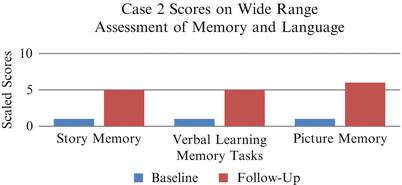

Fig. 4
Scaled scores of 9–11 are in the average range
Ann received homebound teaching for 1 month following her discharge from rehabilitation and was then transitioned to her public school. Ann’s cognitive and physical impairments necessitated educational accommodations and supports. Ann’s medical records and neuropsychological evaluation were presented to the school and an ARD meeting was convened to consider the documentation presented by the family. To receive special education services under the TBI classification, the school required Ann’s physician to attest to the presence of a TBI as well as describe the nature of her impairments. Ann’s IEP contained goals for her basic academic development in reading, math, and written language as well as goals for speech/language, occupational, and physical therapies provided by the school.
Transitioning to the public school was challenging in many ways for Ann. She did not know students from the school prior to her injury and she struggled with learning the layout of the school. We created a memory book for Ann that she carried with her to her classes. The book contained pictures of her current high school, pictures of her teachers and their names, her schedule, and a brief history of Ann (information about herself, her family, and her injury). On the cover of the book was a monthly calendar which was very useful in helping Ann stay oriented to date. Ann frequently referenced this book during her first year at school. Ann was placed in self-contained special education classes which had students with a variety of developmental disabilities. The teaching format in the self-contained classrooms allowed for slower presentation of information. Ann was the only female student and the only student with an acquired brain injury in the self-contained classes. For the first 6 months, Ann had a 1:1 aid throughout the school day. The aid assisted Ann with classroom activities such as finding pages in a textbook, completing worksheets, and taking notes. As Ann’s cognitive status improved, the aid’s support was gradually reduced and eventually eliminated by 6 months. Because of right-sided hemiplegia, her gait was unsteady and slow. She was unable to transition from class to class safely. After the fulltime aid was discontinued, an aide was assigned to walk her to and from classes and she was allowed to leave classes 10 min early in order to avoid the hallway crowds at period changes. An aide was called to the classroom to escort Ann to the restroom if needed. Ann struggled to learn to write with her right hand but she persevered with the assistance of her occupational therapist and eventually her writing was mostly legible.
A concern for her family was Ann’s personal safety at school. She was a young woman who was very trusting of others and could easily be manipulated. These issues were raised with the ARD committee and they agreed that Ann would be supervised in all group settings. Because of concerns about her safety in the school cafeteria, Ann was allowed to eat lunch in the counselor’s office at school, an accommodation she maintained throughout her time in high school.
Ann was re-evaluated 18 months post-injury and these scores are presented in Figs. 4, 5, 6, and 7, along with Ann’s baseline scores. Consistent with the literature, marked gains were noted on the Wechsler Intelligence Scale for Children-III Performance subtests [43]. Although Ann’s performance improved by at least three scaled points on the three Performance subtests, her scores remained below average. Her performance on Wechsler Intelligence Scale for Children-III verbal subtests remained stable with a significant increase in expressive vocabulary. Ann’s verbal and visual memory performance on the Wide Range Assessment of Memory and Language also significantly improved although her scores remained below average. Gains were less dramatic in Ann’s academic skills as assessed on the Woodcock-Johnson Tests of Achievement-Revised. Her skills remained well below average. These findings were consistent with Ann’s functional gains. By the follow-up evaluation, she was independent for activities of daily living such as bathing and dressing. She was also functioning independently in the classroom but continued to need accommodations such as extended time for completion of tests and assignments, use of a word bank for short answer tests, copies of the teacher’s notes, and an aide for transitioning between classes.
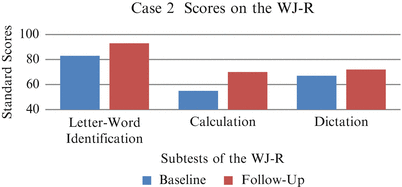
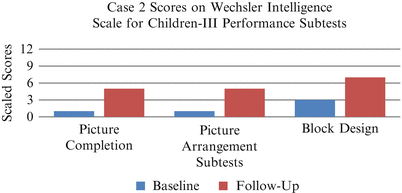
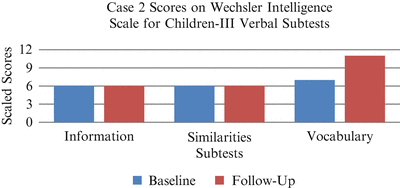

Fig. 5
Standard scores of 90–109 are in the average range

Fig. 6
Scaled scores of 9–11 are in the average range

Fig. 7
Scaled scores of 9–11 are in the average range
Ann’s parents struggled with the change in their child’s functioning. As is common during the first year following injury, they held on to the belief that it was simply a matter of time before she would return to “normal.” The results from our initial evaluation indicated below age and grade skills in most cognitive and academic areas. To help the parents understand the extent of their daughter’s injury, we met with the parents and reviewed the various injuries sustained by the brain using a 3D model of the brain and copies of neuroimaging studies. Although the parents had been told of the CT/MRI findings over the course of the Ann’s medical hospitalization, the information was presented at time when they were in acute distress about the child’s survival and were not able to grasp the information. Understanding the nature of the damage sustained by their daughter’s brain, although very upsetting to the parents, helped them eventually come to terms with their daughter’s impairments. Often times, information regarding the injury needs to be repeated frequently with increasing details during the child’s recovery [88]. Education of parents/guardians of children with TBI is an essential role of the neuropsychologist. Neuropsychological evaluations provide a critical opportunity for the child’s strengths and weaknesses to be discussed in depth with the parents, to provide information about the functional impact of these deficits, to recommend appropriate interventions, and assist with long-term planning. It is important to provide parents with a listing of local, state, and national organizations for individuals with TBI. These organizations can provide an opportunity for parents to network with other families of children with TBI for support and to share information.
Family Environment
Family environment is a crucial factor affecting outcomes. Behavioral, cognitive, and social outcomes from TBI have been found to be moderated by positive and supportive family environments [28, 76, 89, 90]. At the time of the accident, Ann’s parents had been married for 20 years and had three younger children. Her father worked in a management position and her mother was a homemaker. The family dynamics were positive and during the first year post-injury, the focus of the family was on Ann’s recovery. The parents worked as a team to meet her needs at home as well as her various therapy appointments. Her family had the financial resources to provide intensive therapies to improve her communication skills and her motility. The family had an extensive support system that helped provide care for the younger children in the family as the parents tended to Ann’s needs. Ann’s family environment was almost ideal in encompassing positive predictors of recovery. What was not evident to those of us who worked with the family was the toll the injury was taking on the parents themselves. One year after Ann’s injury, her parents separated and subsequently divorced. Both parents reported that the stress of Ann’s injury and recovery had strained their relationship.
Marital discord following serious illnesses and injuries in children is well documented in the literature and many of the same issues apply to families of children with TBI. Parental stress and family functioning has been found to be related to increased behavioral issues in children with TBI [12, 91]. In Ann’s case, she experienced sadness and guilt regarding her parent’s divorce and worked with a therapist to process her feelings. When working with a child who has sustained a TBI, it is essential to work with the entire family and support system [92]. Even those in the best circumstances can succumb to the stress and burden of a severe injury.
Stay updated, free articles. Join our Telegram channel

Full access? Get Clinical Tree





